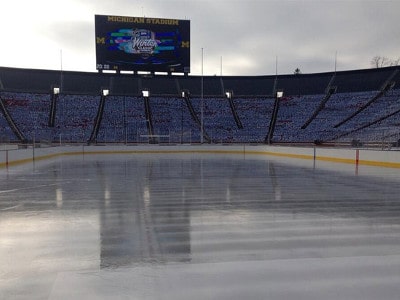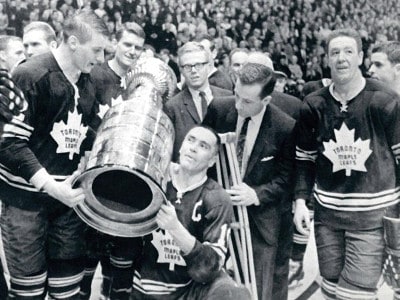

With the 2014-2015 National Hockey League season about to get underway, the NHL will be scrutinizing a few of its more wasteful practices as highlighted in its very first Sustainability Report, published this past summer. The NHL, while not single-handedly a significant climate villain, does require a lot of increasingly scarce resources to operate. For example, a single sheet of rink ice requires 12,500 gallons of water.
Often enough, major organizations produce white papers or issue press releases as a way of signalling a commitment to environmental causes, paying lip service in order to mark themselves out as good corporate citizens without actually doing much of anything.
In the case of the NHL, however, Commissioner Gary Bettman makes clear in the Sustainability Report’s introductory section that the league is committed to pushing good environmental policy mainly because it affects ice hockey’s bottom line. He points to scientific research published in 2012 that documents a 20-30% decrease in the length of the Canadian skating season since 1951, with the biggest drops taking place in Alberta, eastern British Columbia and southern Saskatchewan.
Bottom line for the NHL: shortened winter means less hockey. So, for the good of the game, we’ve got to do something about climate change.
Former Rangers goalie Mike Richter writes, “For me, the beauty of a frozen lake is more than free ice time; it is freedom itself. As enjoyable as the simple act of skating is — its efficiency, rhythm and speed — to skate outside is altogether different. It is pure magic. Here is where young players, limited only by their imagination, develop their true genius for the sport.” He continues, “So it is truly a loss when these opportunities vanish in the shifting terrain of climate change.”
Since 2008, the NHL has been working with the U.S.-based National Resources Defence Council on the NHL Green Initiative. The NRDC is part of a broad coalition of American environmental organizations that are on-record as opposing the Keystone pipeline project, which you might think would make them queasy bedfellows for the NHL, who are stewards of Canada’s game at the highest professional level.
But Gary Bettman makes it clear that the NHL’s stance makes good economic sense from the hockey-business standpoint. “Most of our players learned to skate on outdoor rinks,” he writes on the NRDC’s website. “For that magnificent tradition to continue through future generations we need winter weather — and, as a league, we are uniquely positioned to promote that message. We are thrilled to be able to work with the NRDC and to draw upon its vast experience and expertise in greening League events and League and Club operations.”
In the report, the NHL estimates that its 30 member arenas use more than 321 million gallons of water each year, a lot of which is wasted through inefficient plumbing and old-fashioned toilets.
The report provides a handful of case studies, which make clear that energy efficiency initiatives until now have been left up to individual clubs. The Florida Panthers, for example, managed to reduce restroom sink water consumption by 75% by retrofitting its 400 hand sinks with a water-saving insert.
The Staples Center in Los Angeles went ahead and replaced all 178 of its public urinals with waterless urinals in 2009, making for a water saving of 7 million gallons per year.
The greatest innovation for the actual ice surface, though, was achieved by the Winnipeg Jets at the MTS Centre. By using a process of reverse osmosis, where they had previously been using a chemical water treatment process, the Jets staff found that the new process produced a demineralised water, free of impurities, which resulted in harder, purer ice. This ice requires less maintenance and reduced refrigeration resources, as well as less flood water, which is often used to smooth out rough ice mid-match.
Currently, utility and waste data are gathered manually; information prepared by utility and service providers is relayed through the facility operations teams of all 30 Clubs and assembled at the League.
Dr. Allen Hershkowitz, of the Natural Resources Defence Council, refers to ice hockey as the “canary in the coalmine” of professional sports, owing to the idea that if we lose ice rinks, and therefore hockey, it’s a bad sign for the climate in general. He also points out that while the Sustainability Report is a brave initiative on the part of the NHL, it’s also honest about its limits.
“During the 2012-13 season the League and its Clubs were collectively responsible for approximately 327,031 tons of CO2E emissions (scope 1 and 2 emissions including available, though limited, refrigerant data), and 385,912 tons of CO2E emissions (when including Scope 3 League and Club air travel, arena waste and recycling),” he writes. “By way of comparison, our global economy emits 90 million tons of carbon each day, and the annual CO2E emissions from our nation’s single largest coal power plant by itself totals 23 million tons per year. New York State alone has 90 power plants that collectively emit a total of 35 million tons of CO2E annually. Relative to those sources, the NHL’s footprint is small, and it is a tribute to the League’s commitment to documenting its carbon impacts that it still felt responsible to publicly report its emissions.”
The Sustainability Report points out that most of the NHL’s work remains ahead. It will take years to implement its stated goals of reducing the league’s annual CO2 emissions from 528 to 322 metric tonnes, as well as dramatically reducing both its material and water waste.
The report also sets out a goal of developing a real-time advanced reporting system for managing its operations data. “Currently, utility and waste data are gathered manually; information prepared by utility and service providers is relayed through the facility operations teams of all 30 Clubs and assembled at the League.”
Here’s a thought. The NHL hasn’t publicly reached out through any request for proposal to find candidates to develop this reporting system they’re going to need to implement. What better way to bring Canada’s game into the 21st century than by reaching out to Canada’s tech community, who have been developing real-time data analysis solutions for years now?
Comment
One thought on “The NHL, which uses millions of gallons of water a year, needs tech solutions”
Leave a Reply
You must be logged in to post a comment.





 Share
Share Tweet
Tweet Share
Share




Thanks, an informative article.
As Gladwell says “first impressions are to be questioned?”. ie. Who would think that Gary Bettman “the corporate Americanizer of hockey” would be drilling down to the hockey ponds, small town and inner city outdoor rinks that produced the Gordie Howes’ (Sask), Rocket Richard’s (east end Montreal) and even many of the newer ‘too cool for school” $10MM players. (Gretzky’s dad’s Brantford backyard rink).
A corporate admission of “global warming”? But, it all starts there for many of the best players and Mr Bettman is looking at the source- and see’s it lowering his input.- practical business.
But for those of us who have been rink rats since the sixties, easy to see the pickup season getting shorter, with annoying “warm spells” in January etc. In fact, seems many towns give up on the outdoor rinks as arena’s have popped up many towns less than 5,000 (ie where I live). But I find that these smaller arenas are damp and poorly ventilated and smell like refrigerators- which they are.
It’s interesting to note how the best players always draw a strong emotional attachment to the “early days when they got the bug on an outdoor rink” as Mike Richter did.
regards,
Stuart Armstrong
(rink rat, Williamstown, ONT)